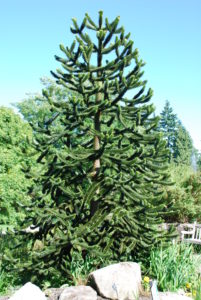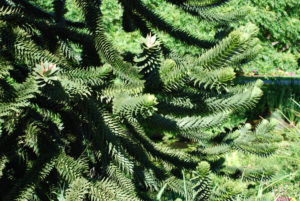Monkey puzzle tree or Chilian pine (Araucaria araucana) is an evergreen conifer that is indigenous to forested volcanic slopes in the Andes Mountains in Chile and Argentina (USDA Zone 7b-11). It is the national tree of Chile.
It typically grows 60-70 feet tall and 30-35 feet wide, but frequently reaches 100 feet or more in height in its native habitat. The tree exhibits a loose pyramidal form when young, but develops an umbrella-like crown with loss of its lower branches as it ages.
Dense, leathery, triangular, radially-arranged leaves are sharply pointed. The 2-inch long evergreen leaves are glossy, dark green, and closely overlapping each other. Leaves persist for 10 to 15 years. Branches develop along a straight trunk in tiers. Upward-arching branches are arranged in whorls around the trunk.. Monkey puzzle forms few side branches. The female cones are globular that are up to 8 inches in diameter; male cones are cylindrical and up to 5 inches long. Bark is gray-brown and ridged.
It is best grown in deep, moderately fertile, evenly moist, well-drained soils in full sun to part shade. Trees grow well in average soils provided they’re well-drained. Trees perform much better in mild summers than in hot tropical climates. In northerly areas, trees can be grown in containers and brought indoors in winter and kept in bright indirect sunlight.
Trees are dioecious (separate male and female trees). Seeds (pinones) are edible and reminiscent of pine nuts. They are rarely troubled by serious insect or disease problems. Needle necrosis and leaf spots are rare problems as are mealybugs, scale and thrips.
Monkey puzzle is related Norfolk Island pine (A. heterophylla), a popular house plant for sale at garden shops during the winter holiday season in the U’S. and Canada.



 Posted in
Posted in 
